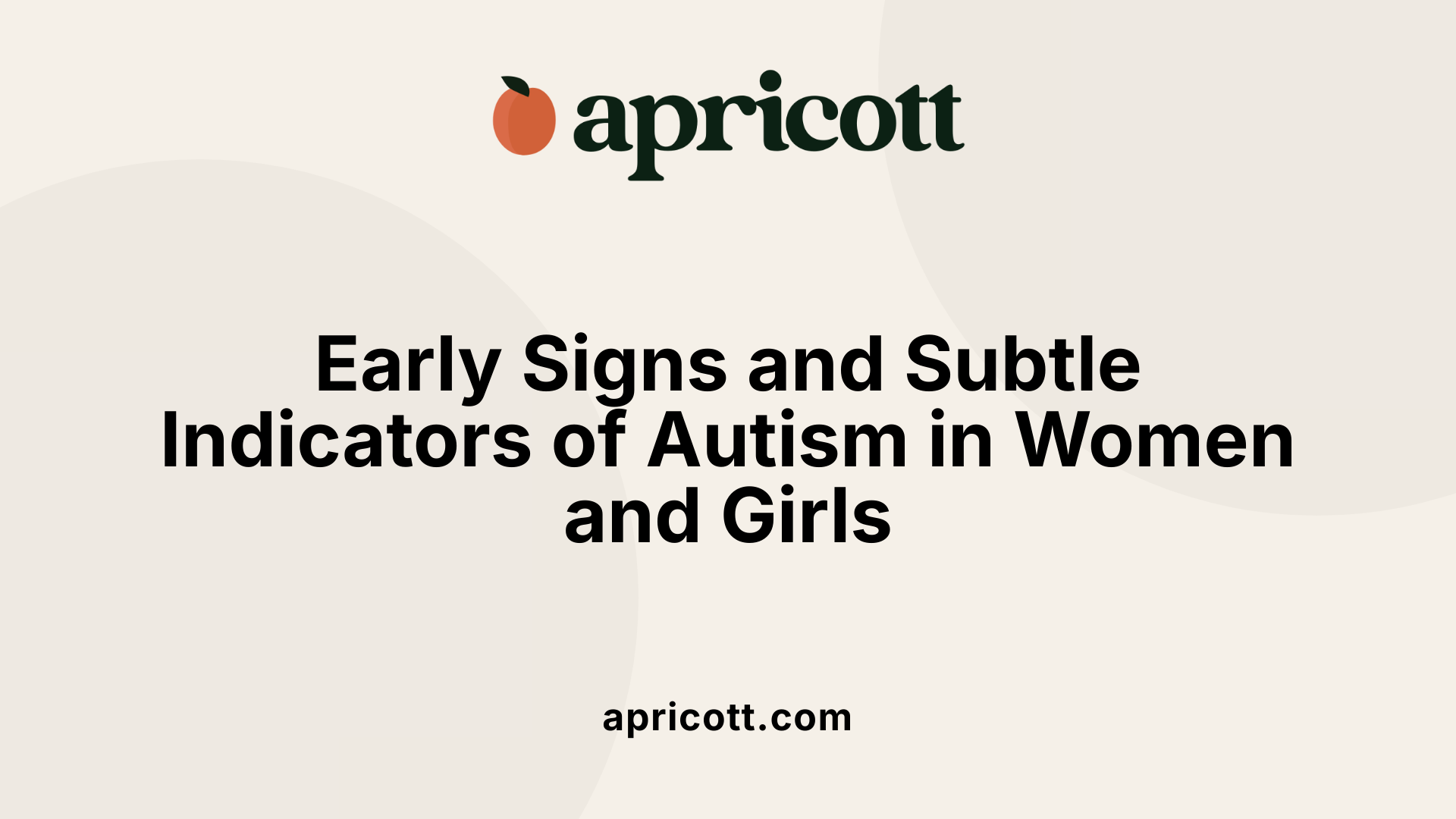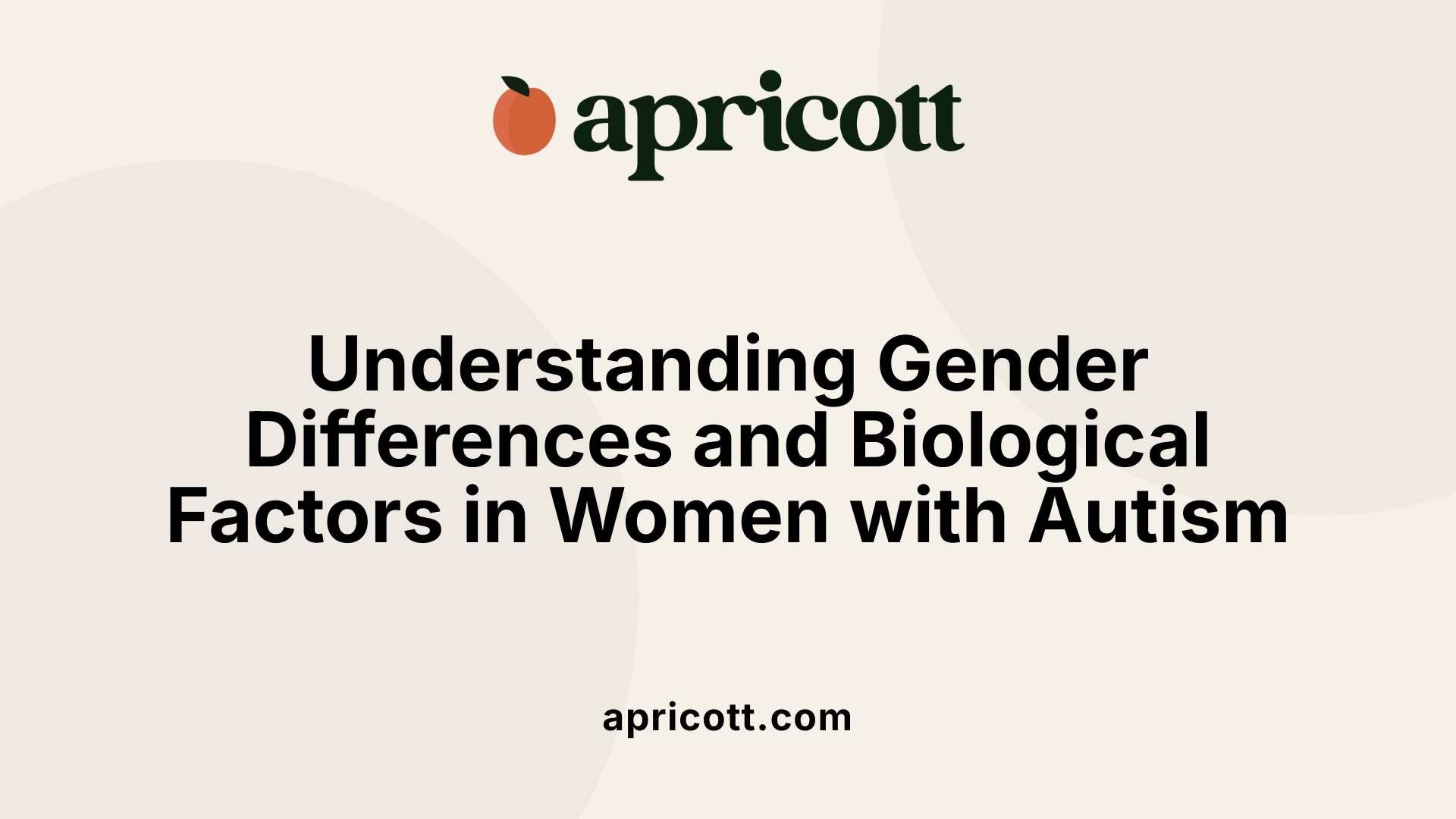July 30, 2025
Unveiling the Hidden Spectrum: Understanding Autism in Women
Autism Spectrum Disorder (ASD) has long been understood through a male-centric lens, leading to significant underdiagnosis and misdiagnosis among women and girls. Recent research is shifting this narrative, revealing complex gender-specific differences that influence how autism manifests, is perceived, and is diagnosed. Recognizing these nuances is crucial for ensuring women receive the support and understanding they deserve. This article explores how autism presents differently in women, the challenges they face in diagnosis, and the resources available to empower them.

Autism in females often presents with subtler signs that can easily be overlooked, especially by those unfamiliar with gender-specific expression of traits. Unlike many boys who may exhibit more overt repetitive behaviors or intense, unconventional interests, girls and women tend to develop more socially acceptable interests, such as animals, literature, or celebrities.
They generally display better social skills, including maintaining conversation, sharing interests, and perceiving social cues, which can mask their difficulties. These skills may allow them to navigate social environments more smoothly, but often at the expense of internal stress or emotional fatigue.
To hide their differences, many females engage in masking or camouflaging behaviors. These include forcing eye contact, mimicking facial expressions and body language, using rehearsed scripts in social situations, and suppressing repetitive movements or stimming behaviors. This masking can be conscious or unconscious and is often driven by a desire to fit in or avoid stigma.
Such strategies make autism in women less obvious, leading to delayed diagnoses or misclassification as social anxiety or other mental health conditions. The presentation is often characterized by fewer overt signs like hand-flapping or rocking, and more internalized symptoms, such as anxiety, depression, or emotional dysregulation.
Recognizing these differences is crucial for accurate diagnosis, as it helps differentiate autism from other psychological issues and highlights the need for tailored assessment tools that consider female presentations.
Masking behaviors in women and girls with autism are sophisticated and varied. They might rehearse social interactions, memorize social scripts, analyze their body language, or develop elaborate routines to navigate social settings.
While effective at helping them blend in temporarily, these behaviors can lead to mental health challenges like burnout, anxiety, or depression, especially when sustained over long periods. Many women may only realize they are autistic after experiencing significant emotional or physical exhaustion.
Women often have interests that align closely with societal norms, such as a love for animals, books, or pop culture, which can be mistaken for normal hobbies. Their social difficulties might also not be readily apparent because they can engage well in superficial conversations.
However, underneath these social facades, they might struggle with sensory sensitivities, rigid routines, or intense focus on particular interests. These traits are often less overt than in males, requiring careful observation and understanding to recognize.
By understanding these gender-specific ways autism manifests, clinicians, educators, and families can better support women and girls on the spectrum.

Autism in women and girls often presents with subtle differences compared to males, which can make it harder to identify. Common signs include social difficulties, such as trouble understanding social cues, forming and maintaining friendships, and feeling exhausted after social interactions. These individuals may also have sensory sensitivities, reacting strongly to lights, sounds, or textures that others might ignore.
Executive function challenges are prevalent as well. This can manifest as difficulty organizing tasks, managing time, or coping with changes in routine. Many women with autism develop intense, focused interests—sometimes in socially acceptable topics like animals, art, or celebrities—that may seem normal or even impressive but mask underlying autism traits.
A hallmark of autism in women and girls is their tendency to mask or camouflage their difficulties. They might rehearse social scripts, imitate facial expressions or mannerisms, or suppress behaviors like stimming to blend in. This masking helps them seem socially competent on the surface, but it often leads to significant mental health strain, including anxiety and depression.
Internalized symptoms are also notable. Women with autism frequently experience mood disorders, such as anxiety and depression, which are often overlooked or attributed to other mental health conditions. Sleep disturbances, emotional regulation issues, and repetitive behaviors are common too.
Recognizing these signs early can facilitate diagnosis and access to tailored support. Since autism in females can be less overt than in males, awareness of these nuanced traits is crucial for clinicians, families, and women themselves.
Diagnosing autism in women presents a range of difficulties that stem from how autism manifests differently compared to males. Traditionally, diagnostic tools and criteria have been rooted in male presentations, which often emphasize more overt behaviors like repetitive movements or noticeable social difficulties. In contrast, women with autism tend to display subtler signs, such as fewer outward behavioral issues and a tendency to mask their struggles.
Many autistic women develop sophisticated camouflage strategies, known as masking behaviors, which include mimicking social cues, rehearsing conversations, and suppressing natural tendencies like stimming. These behaviors help them appear socially typical but conceal underlying challenges, making outward diagnosis difficult.
Societal stereotypes also play a significant role. Women are often expected to be more socially adept, nurturing, and compliant, leading both families and healthcare providers to overlook signs of autism. Because women tend to internalize their difficulties—experiencing anxiety, depression, or social withdrawal—these symptoms can be mistaken for mental health issues rather than signs of autism.
Furthermore, systemic issues such as limited awareness among professionals, lack of training specific to female autism presentations, and the absence of assessment tools that account for gender differences all contribute to underdiagnosis. This is especially true for adult women who have spent years masking their symptoms, often leading to late diagnoses or misdiagnoses, which can delay access to appropriate support and interventions.
In summary, diagnosing autism in women is complicated by gendered presentation differences, societal expectations that promote masking, and systemic biases within healthcare. Raising awareness and improving assessment methods tailored to women’s experiences are essential steps to ensure timely and accurate diagnosis.

Women with autism face unique challenges shaped by biological, societal, and psychological factors. One major consideration is the tendency for delayed diagnosis. Historically, autism in women has been underrecognized because their presentation often differs from stereotypical male traits. They are more likely to mask or camouflage their symptoms through behaviors like copying facial expressions, rehearsing social scripts, or suppressing natural autistic responses.
This masking, or camouflaging, complicates detection and can lead to mental fatigue, burnout, or mental health issues such as depression and anxiety. Many women are not diagnosed until adulthood, often after enduring years of internalized struggles and mental health conditions that overshadow their autism.
Biologically, emerging research indicates differences in brain organization and gene expression between males and females with autism. Variations in neural connectivity, hormonal influences, and the interaction of sex hormones with brain development—sometimes called the

Women with autism have access to a variety of resources and support networks designed to meet their unique needs. Online platforms and websites provide valuable information, community forums, and articles from trusted autism advocates that help women understand their experiences and find guidance. Support services range from diagnostic assistance to tailored therapies, employment training, and social groups that foster connection and understanding.
Specialized organizations and networks like Autism Empowerment, Aspire, and other community-based groups offer training, mentorship programs, and community engagement opportunities specific to women and girls on the spectrum. These organizations often provide workshops, awareness campaigns, and peer support to promote acceptance.
Support for housing and living arrangements is also available through programs that offer guidance on supportive accommodations and residential supports, helping women live independently or in supported environments. Additionally, professional training initiatives aim to educate healthcare providers, educators, and employers to better recognize, diagnose, and support women with autism, creating a more inclusive society.
Yes, many women on the spectrum have shared personal stories that shed light on their lived experiences. These accounts often reveal the subtleties of autism in females, such as masking behaviors, sensory sensitivities, and social challenges that may not be immediately evident. Women recount feelings of social exhaustion, anxiety, and burnout resulting from the effort required to hide their differences.
Personal stories also celebrate strengths like creativity, empathy, and resilience. Initiatives like video projects, blogs, and research studies featuring women’s testimonies help raise awareness, reduce stigma, and foster understanding. Sharing these experiences is vital to validating women’s feelings and promoting greater societal acceptance of neurodiversity.
As awareness grows, more women are recognizing their autism later in life and are finding community support, which is instrumental in improving their quality of life and mental health.
 Recent studies on autism in women reveal that its presentation often differs significantly from that in men. Many females on the spectrum engage in masking or camouflaging behaviors—such as mimicking social cues, rehearsing conversations, or hiding their interests—to blend in with peers. This adaptive behavior makes diagnosis harder because their symptoms tend to be more internalized, manifesting as anxiety, depression, and emotional struggles, rather than the more obvious social difficulties seen in males.
Recent studies on autism in women reveal that its presentation often differs significantly from that in men. Many females on the spectrum engage in masking or camouflaging behaviors—such as mimicking social cues, rehearsing conversations, or hiding their interests—to blend in with peers. This adaptive behavior makes diagnosis harder because their symptoms tend to be more internalized, manifesting as anxiety, depression, and emotional struggles, rather than the more obvious social difficulties seen in males.
Traditional diagnostic tools have historically been based on male-typical traits, which means many women do not meet the criteria as clearly, leading to missed or delayed diagnoses. For example, women often display better social reciprocity, higher empathy, and interests that are more socially acceptable, like animals or literature, further masking their autism. Consequently, many women are diagnosed late into adulthood, sometimes only after other mental health conditions are identified.
The Female Phenotype Theory (FPT) offers a framework for understanding these differences. It suggests that autistic women tend to present with less overt impairments in social interaction, making their condition less obvious. This theory helps explain why many women remain undiagnosed for years or are misdiagnosed with conditions like Borderline Personality Disorder or anxiety disorders due to overlapping symptoms.
Advancing research emphasizes the importance of inclusive and gender-sensitive approaches. Understanding gender diversity among autistic individuals and refining diagnostic criteria are crucial steps forward. More comprehensive studies that include gender-diverse autistic populations are needed to ensure that support and resources are designed to meet the varied needs of women.
As awareness increases, medical and psychological communities are working toward better diagnostic tools, greater recognition of subtle presentations, and tailored interventions that account for gender-specific features. These efforts aim to improve the quality of life and support systems for autistic women, allowing for more accurate diagnosis, effective treatment, and enhanced societal inclusion.
For further exploration, searching for "Research on autism in women" provides a wealth of information on latest insights, emphasizing the importance of gender-aware approaches in autism diagnosis and care.
As awareness of the unique ways autism manifests in women grows, so does the importance of developing more inclusive diagnostic practices, resources, and support systems. Recognizing the gender-specific nuances in symptoms, ensuring early and accurate diagnosis, and fostering understanding and acceptance are vital steps toward empowering women on the spectrum. Personal stories, ongoing research, and dedicated resources highlight the progress made and the road ahead. Creating a more inclusive environment not only benefits women with autism but enriches societal understanding of the spectrum as a whole, promoting diversity, empathy, and true inclusion.